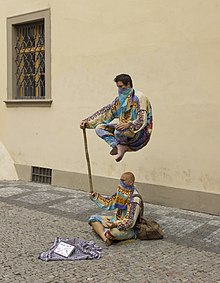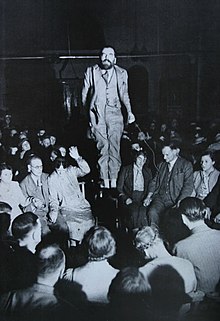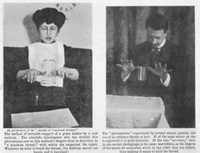Levitation (paranormal)

| Part of a series on the |
| Paranormal |
|---|
| New Age beliefs |
|---|
 |
| Concepts |
| Spiritual practices |
| Doctrines |
Levitation or transvection, in the
While believed in some religious and
Religious views
Various religions have claimed examples of levitation amongst their followers. This is generally used either as a demonstration of the validity or power of the religion,[6] or as evidence of the holiness or adherence to the religion of the particular levitator.
Buddhism
- It is recounted as one of the
- Vajrayana Buddhist guru, was rumored to have possessed a range of additional abilities during levitation, such as the ability to walk, rest and sleep; however, such were deemed as occult powers.[citation needed]
Christianity
- According to three Lake Galilee to meet his disciples who were in a boat.[7]
- Saint river Jordan according to her hagiographer, the hermit Zosimas of Palestine[8]
- Saint Bessarion of Egypt (died c. 466), is said to have walked across the waters of the river Nile[9][10]
- cubits". This is about 1.3 to 1.8 m (4 ft 3 in – 5 ft 11 in).[11]
- Saint
- Carmelite nun and Doctor of the Church, claimed to have levitated at a height of about a 1.5 feet (0.46 m) for an extended period somewhat less than an hour, in a state of mystical rapture. She called the experience a "spiritual visitation".[15]
- Saint Martín de Porres (1579–1639), a lay brother of the Dominican Order, claimed psychic powers of bilocation, being able to pass through closed doors (teleportation), and levitation.[16]: 227
- Joseph of Cupertino (1603–1663), a Franciscan Friar, reportedly levitated high in the air, for extended periods of more than an hour, on many occasions.[17]
- Alphonsus Liguori (1696–1787), when preaching at Foggia, was purportedly lifted before the eyes of the whole congregation several feet from the ground.[16]: 13
- Girolamo Savonarola, sentenced to death, allegedly rose off the floor of his cell into midair and remained there for some time.[18]
- Seraphim of Sarov (1759–1833), Russian Orthodox saint, allegedly had a gift to levitate over the ground for some time, witnessed by many educated people of his time, including the emperor Alexander I of Russia.[19]
- Discalced Carmelite nun of the Melkite Greek Catholic Church, experienced frequent ecstasies. She was purportedly seen levitating more than once by others: for example, in the garden of the monastery during times of private prayer, when living in the Carmelite monastery at Pau, in France.[20][page needed]
- "Demonic" levitation in Christianity
- Simon Magus is recorded in the Acts of Peter as levitating above the Forum in Rome in order to prove himself to be a god. The apostle Peter intervenes, causing Magus to drop from the sky, breaking his legs "in three parts".[21]
- Clara Germana Cele, a young South African girl, in 1906 reportedly levitated in a rigid position. The effect was apparently only reversed by the application of Holy water, leading to belief that it was caused by demonic possession.[15]: 328
- Magdalena de la Cruz (1487–1560), a Franciscan nun of Cordova, Spain.[22]
- Margaret Rule, a young Boston girl in the 1690s who was believed to be harassed by evil forces shortly after the Salem Witchcraft Trials, reportedly levitated from her bed in the presence of a number of witnesses.[23]
Gnosticism
- magical powers.[24]
- Mani, founder of Manichaeism, was reputed to be able to levitate.[25]
Hellenism
- It was believed in pagan religion of Ancient Greece and Ancient Rome) on the testimony of Philostratus that upon his death, Apollonius of Tyana underwent heavenly assumption by levitating into Elysium.[26]
Hinduism
This section needs additional citations for verification. (December 2016) |
- In HinduYogis who levitated in the course of their meditation.
- Yogi Subbayah Pullavar was reported to have levitated into the air for four minutes in front of a crowd of 150 witnesses on June 6, 1936. He was seen suspended horizontally several feet above the ground, in a trance, lightly resting his hand on top of a cloth-covered stick. Pullavar's arms and legs could not be bent from their locked position once on the ground. The illusion was created by a simple method in which the person seen to levitate is supported by a cantilevered platform held up by an iron rod camouflaged in some way.[5]
Levitation by mediums


Many mediums have claimed to have levitated during séances, especially in the 19th century in Britain and America. Many have been shown to be frauds, using wires and stage magic tricks.[28] Daniel Dunglas Home, a prolific and well-documented levitator of himself and other objects, was said by spiritualists to levitate outside a window. Skeptics have disputed such claims.[29] The researchers Joseph McCabe and Trevor H. Hall exposed the "levitation" of Home as nothing more than him moving across a connecting ledge between two iron balconies.[30]
The magician
- "Joseph F. Rinn and Warner C. Pyne, clad in black coveralls, had crawled into the dining room of Columbia professor Herbert G. Lord's house while a Palladino seance was in progress. Positioning themselves under the table, they saw the medium's foot strike a table leg to produce raps. As the table tilted to the right, due to pressure of her right hand on the surface, they saw her put her left foot under the left table leg. Pressing down on the tabletop with her left hand and up with her left foot under the table leg to form a clamp, she lifted her foot and "levitated" the table from the floor."[31]
The levitation trick of the medium
In photography
A person photographed while bouncing may appear to be levitating. This optical illusion is used by religious groups and by spiritualist mediums, claiming that their meditation techniques allow them to levitate in the air. Usually telltale signs can be found in the photography indicating that the subject was in the act of bouncing, like blurry body parts, a flailing scarf, hair being suspended in the air, etc.[3]
Levitation in popular culture
Literature
- Incidents in my Life autobiography by Daniel Dunglas Home
- Mr. Vertigo novel by Paul Auster
Film
- The Exorcist (1973), directed by William Friedkin
- Ghostbusters (1984), directed by Ivan Reitman
- The Boy Who Could Fly (1986), directed by Nick Castle
- Candyman film series directed by Bernard Rose (1992); Bill Condon (1995); Turi Meyer (1999); Nia DaCosta (2021)
TV shows
- season 4(2022)
See also
References
- ISBN 9781573920216.
- ISBN 9780471272427.
Levitation is the act of ascending into the air and floating in apparent defiance of gravity. Spiritual masters or fakirs are often depicted levitating. Some take the ability to levitate as a sign of blessedness. Others see levitation as a conjurer's trick. No one really levitates; they just appear to do so. Clever people can use illusion, "invisible string", and magnets to make things appear to levitate.
- ^ ISBN 9780813191249.
Some claims — of levitation, for instance — may be performed either as an illusion for an audience, as a magician's stage trick, or for the camera.
- ISBN 9781405181228.
- ^ ISBN 9780674061095. Retrieved 25 October 2019.
- ^ ISBN 9780682244008.
- Bible Gateway. Retrieved 2016-12-19.
- ^ *MacRory, Joseph (1910). . In Herbermann, Charles (ed.). Catholic Encyclopedia. Vol. 9. New York: Robert Appleton Company.
- ^ "St. Bessarion the Great, wonderworker of Egypt (466)". Holytrinityorthodox.com. 2007-02-22. Retrieved 2016-12-19.
- ^ Catholic Online. "St. Bessarion – Saints & Angels – Catholic Online". Catholic.org. Retrieved 2016-12-19.
- ISBN 0486411257.
- ^ "St. Catherine of Siena's Severed Head". Atlas Obscura. Retrieved 2023-05-02.
- New York TimesArchives. Retrieved May 2, 2023.
- ^ Reda, Mario; Saco, Giuseppe (January 28, 2010). "Anorexia and the Holiness of Saint Catherine of Siena". Medievalists. Journal of Criminal Justice and Popular Culture vol. 8 Issue 1. Retrieved May 2, 2023.
- ^ ISBN 9780517162781.
- ^ ISBN 1438130260.
- ISBN 1858285895.
- ISBN 1417967501.
- ISBN 9780913836286.
- ISBN 9782706706684.
- ^ "The Acts of Peter". www.earlychristianwritings.com.
- ISBN 080148572X.
- ISBN 9781589791329.
- ISBN 8798753703.
- ^ Sundermann, Werner (2009), "Mani, the founder of the religion of Manicheism in the 3rd century AD", Iranica, Sundermann
- ISBN 978-0199545568.
- ISBN 019861053X.
- ISBN 9780879752699.
- ISBN 9780879758639.
- JSTOR 3828547.
- ISBN 9780690017601.
- Proskauer, Julien J.(1946). The Dead Do Not Talk. Harper & Brothers. p. 94.
- ^ Fournier a'Albe, Edmund Edward (1922). The Goligher Circle. J. M. Watkins. p. 37.
- ISBN 9780766130074.
- ISBN 9781417981281.
- ISBN 9780712348997.
Further reading
- ISBN 0879753587.
- Andrew Neher (1990). Paranormal and Transcendental Experience: A Psychological Examination (2nd ed.). New York: ISBN 0486261670.
- ISBN 0879751983.
- Gordon Stein (Spring 1989). "The Levitation of the Lore". Skeptical Inquirer. 13 (2): 277–288.
External links
- Levitation by Mark Edward
- Levitation – Skeptic's Dictionary
- The Flying Mystics of Tibetan Buddhism art exhibit, Oglethorpe University, 2004
